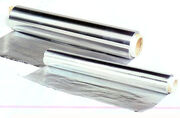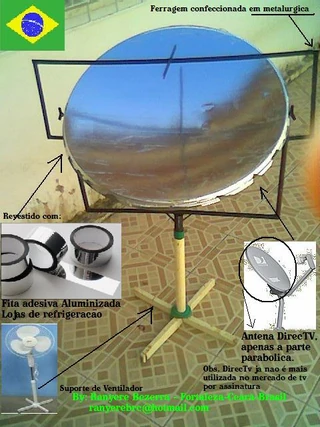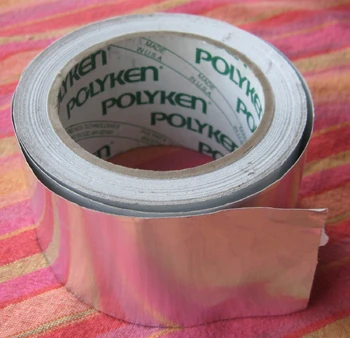Tom Sponheim (talk | contribs) |
Tom Sponheim (talk | contribs) |
||
| Line 127: | Line 127: | ||
*[http://www.usc.edu/CSSF/History/2007/Projects/J1207.pdf In Hot Water: Comparing the Effectiveness of Reflective Material in Solar Ovens] - ''Jasmine Griffin'' |
*[http://www.usc.edu/CSSF/History/2007/Projects/J1207.pdf In Hot Water: Comparing the Effectiveness of Reflective Material in Solar Ovens] - ''Jasmine Griffin'' |
||
| − | *[ |
+ | *[[Lingding New Energy Co., Ltd]] sells a number of [http://lingding.en.alibaba.com/productlist-3.html reflective films] |
[[Category:Materials]] |
[[Category:Materials]] |
||
Revision as of 17:00, 26 August 2010
General information

Standard kitchen aluminum foil works very well for solar cooking reflectors.
The most common reflective material used in homemade solar cookers is plain aluminum foil. This can be glued very well with white glue or wheat paste.
Mylar is a brand name used by the DuPont corporation to identify thin polyester plastic films that it makes. Actually, DuPont and a Japanese company have created a joint company called DuPont Teijin Films to handle the polyester film business.

A simple windshield shade can be used as a reflector.
It also appears that many large companies in different parts of the world produce similar products. It also appears that some companies may buy the polyester film from companies such as DuPont and then add the aluminum coating themselves, before distributing to consumers. In other words, there may be dozens, scores or hundreds of companies that sell polyester films with aluminum coating. This may make it very impractical to trace a supplier for you in Port Harcourt through the manufacturers, which is what I tried to do in my email to DuPont Teijin.
Solar cooker experimenters in Kenya, Ethiopia, Tanzania, Peru and Bolivia have all found that gift wrap can be found easily that can be used for making reflective surfaces for solar cookers. Glues made from flour and water or "wheat paste" work well enough to hold the gift wrap onto the CooKit. The gift wrap is like a mirror on one side (the aluminum) and a color on the other side. So, if I can't find better information through DuPont Teijin, you might find that just shopping for shiny gift wrap is the most practical solution.

A funnel cooker made out of wood, using old beer and drink cans (cut open, flattened and then stapled to the wood) as reflectors
From the information I currently have, it seems that these polyester products are not suitable for lining the inside of a solar box cooker, because of the danger that at the temperatures inside the box-type cooker, the polyester would melt or at least give off foul smelling foods. I am told that this problem does not necessarily show up the first time one uses a cooker made with these materials--that it may show up after five or ten or twenty uses.
Therefore, I would suggest that the polyester or gift wrap material only be used for CooKits or for the reflectors on box cookers that are outside the box.
Ravindra Pardeshi writes:
Also note that most metals cannot be polished enough to be reflective enough for solar cooking. One exception is anodized aluminum. Metallic paints usually do NOT reflect well enough. We polish the assembled cooker of sheets. We do the polishing in two ways:
- Professional buffing service
- On our own. This is very crude way but works. First we polish the surface with fine cloth and fine tooth powder and then with one localy found polishing liquid. Results are quite satisfying. For repolishing we use liquid polish only.
Use the foil from cigarette packages
Most cigarette packages have a inner foil liner. Collect these and use them in a patchwork fashion to create a reflective surface.
Mirrors made from decal/stickers
Chrome mirror sign vinyl is excellent for most solar cooking applications where the material itself is not touch the hottest part. It is made to be used on business signs and is designed to stand up to many trips to the car wash. This material can turn nearly anything into a powerful mirror. You can find it on the internet. You must use phrases like "Chrome mirror sign vinyl", or, ""Mirror sign vinyl, or Gold sign vinyl. This material is available in a self-adhesive roll. You can find short rolls or long and wide rolls. The rolls start at inchers in width to feet in width. Apply it with soapy water in the same way as window tint. After some exposure to warmth, the soap vanishes and your mirrors will stick for years. Keep them shiny with wax, oil, Scott's liquid gold, experiment with it.
A flexible cutting board could make a good mirror. When finished cutting the underside of the cutting board may have a mirror on it to help cook the food you cut up.
Think of the many shapes we have availble. Now you can turn junk into ovens and dish cookers. Here are some things I know would make terrific ovens and parabolic, and parabolic hybrids. A thermal parabolic hybrid oven will acheive temperatures hotter than needed for normal cooking, when combine with thermal cookware it is nearly dangerous.
It is dangerous. Be careful. It will take some time to adapt to your new abilities. A thermal griddle may be a griddle with ceramic tile in a sandwich of steel or aluminum. ALUMINUM COOKWARE WARNING: See: Aluminum Oxide poisoning. Aluminum loses heat so quickly too. I want my food cooked with glass and ceramic and steel. Matt West
Using the foil on the inside of Tetra Pak juice boxes
Kenya
Solar Cookers International East Africa Office recycles waste from Tetra Pak materials. This is a packaging making industry and sometimes they have waste which they have already prepared, this then we use as our foil. When this is not available they buy from another packaging industry called Pressmasters Ltd.
Here are their coordinates:
Pressmasters Ltd.
P.O. Box 17560 - 00500
Nairobi
Kenya
Fax: +254 20 823044
Tel: +254 20 820253,820254
Mobile +254 722514623 / 733743783
http://www.pressmasterkenya.com
Zambia
Solar Health and Education Project (SHEP) has developed a relationship with Tetra Pak International — manufacturer of aseptic drink containers — whereby SHEP uses Tetra Pak’s excess foil-lined paper for solar cooker construction. (The foil-lined paper is printed in wide rolls, sometimes resulting in excess material begin generated.) According to SHEP, Tetra Pak is willing to accept proposals from other nongovernmental organizations that may want to use the reflective material as long as the material will be used for workshop participants to construct solar cookers.
Make A Flexible Adjustable Parabolic Trough Using Plastic Or Magnetic Sheet
An adjustable parabolic trough will help you fine tune your shapes to heat the way you wish. Start with a plastic FOR RENT sign (PVC SHEET). Take that to a sign shop and ask if they will cover it in chrome mirror sign vinyl decal material. A sign supplier can provide you with various thicknesses of PVC sheet. Sure you can use poster board. It wont last.
Hardware stores have large sheets too; for use in a bathroom, we'll use the smooth back. Now you have a lightweight and flexible mirror. This material is the same kind of material you see on all kinds of advertising signs. It comes in chrome, gold, chrome with a color tint, and more. They have fake gold and real gold.
The material can take quit a bit of heat. It will melt. So if your whole oven gets hot then don't use it. If you are using thermal cookware it should work. It is ideal for any situation where the reflector itself will never be too hot. When the material is on steel or wood, embers have little effect. If an ember lands on the material while not backed or thinly backed with plastic, it will melt. But for many applications it is ideal and comparitively inexpensive. And it's very easy to use. Line the inside of nearly and cavity, aim it at the sun, cover with glass and get cooking.
You don't need finely machined anything. To conduct experiments with it you can try bending it and realizing the results. You'll be able to focus sunlight away at various height for various reasons. This parabolic trough will produce a very powerful beam of light extending as long as you want to go with it. Start for instance by clamping or glueing the center of the mirror to something like a piece of plywood. The middle is fixed now and the sides can be bent and aimed exactly where you like, near, or far to infinity. When you have the sweet spot focal point where you want it you can fix it in position permanently.
The other day it occurred to me that I could use a sheet magnet which is flexible and usually used for magnetic signs, and make a sheet mirror that will stick to parabolically shaped sheet metal. They would be easy to remove and wash. You could stick the walls of your cooker on a metal wall to dry at night.
On the next eliptical or round parabolic dish cooker I can apply a kit of magnet mirror triangles to the dish. The dish is made of steel so the satellite tv company can keep their cost down. Steel is even cheaper than plastic. For us it could be fantastic. With so much steel around we have a wide array of shapes we could stick magnet mirror vinyl too, then cook all day and remove the magnets to clean them as needed.
Magnet mirrors could be used to extend the width of your project a bit beyond the edge of the metal, or to make external mirrors for your oven. I can make a kit for someone if needed. Say goodbye to aluminum foil and expensive mirrors.
Here's another experiment for someone to try: See if mirror window tint can make good enough reflections to be used for cooking somehow. Perhaps it could be applied on plastic sheets, or metal sheets, maybe white ones.
What happens if mirror tint is applied to a solar oven's window so as to try to keep light bouncing around in the box? Could mirror tint be used to make flexible mirrors?
What about using mylar, lexan, or plexiglas mirror? Cooking mirrors don't always need to withstand heat themselves. The food may be hot enough to burn you and the mirrors stay cool.
Build your own Kramer junction or Nevada one power plant. I will try to tell you how. Solar electricity does not have to cost so much. You'll need: Any suitable bendable sheet material in covered with chrome mirror vinyl. You may need a pump for very hot oil, thermosyphoning may be enough to circulate the oil. You'll need a big tank of water for collecting steam, a small steam turbine directly connected to a suitable generator. Add that to the production of hydrogen by electrolosis and you'll have power to get you through the night, and run your car. I envision the same steam generator running on hydrogen quietly during the night hours. Now you don't need a battery bank or some bogus fuel cell contraption designed to keep you dependant on big business. Near morning, the oil could also be easily pre-heated by the hydrogen in anticipation of the sun. We need someone to prove this concept for the good of all mankind. The hot oil pump could be a power steering pump. The top of a mower looks much like a steam turbine. Old cars have generators. I'm just speculating, if you blow yourself up doing this don't blame me. Producing hydrogen by electrolosis uses very little power to create great amounts of power.
Will thermosiphoning circulate hot oil? Will it circulate it through a heat exchanger system steam turbine electricity generator? It works for solar water heaters? If so does the liquid's thermosiphoning speed increase with increased heat? How much? Is there a peak or max or ideal?
A parabolic trough does not have to aim straight at the sun to be effective. The focal point can be eccentric. This will allow you to aim at something without casting shadows on the trough. The trough does not have to be directly under the thing you are heating.
The synthetic oil used at Kramer Junction and Nevada one is probably the same as in your car's engine. Add soot and you have an oil which collects solar heat, I suspect.
The trough could also be covered in glass to retain more heat. More kept heat means more efficiency.
Parabolic disk foiled with reflective tape
 This photo shows how to use a Direct TV antenna as a solar cooker using reflective tape applied in strips. Photo sent by Ranyere Bezerra. |
 Reflective tape can be used to foil parabolic reflectors. |
Lithograph printing plates
Looking for inexpensive, recycled reflective material for solar cookers? Here’s a tip from the SunStove Organization of South Africa: "Lithograph printing plates are available in every country at the government printing office, the local printer or the local newspaper. Used printing plates are sold as scrap." This scrap may be sold for the equivalent of US $1.25 per kilogram. Before using the plates in solar cookers, clean with paint thinner and water.
CDs
- Build a Solar Cooker from old CDs - Tree Hugger
See also
- Investigation of Reflective Materials for the Solar Cooker - John Harrison
- Information on the STEVEN foundation's extra free Mylar
- SolaReflex foil
- Ripple mirror
- Diamond Grade Reflective Materials
Using a white color instead of reflective sheet

The updated Kyoto Box cooker uses a white surface instead of a reflective surface.
External links
- ReflecTech® Mirror Film - a company producing reflective film suitable for solar cookers.
- Lingding New Energy Co., Ltd sells a number of reflective films
